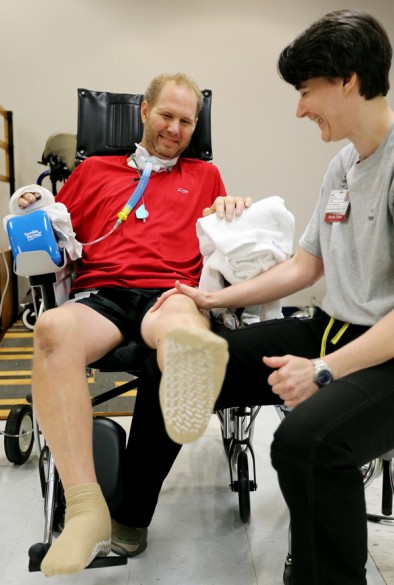After Stacey Browning, R.N., a Cardiovascular Intensive Care Unit charge nurse, got a report on a heart attack patient who was being transported to her unit from an outside hospital, her immediate thought was, “They are sending us a patient we are not going to be able to recover.”
“We’re going to have to tell the family when they get here that we’re sorry but there is nothing we can do, because that’s how bad it sounded,” she recalled.

The patient was Anthony Nolan, a former member of the U.S. military, a recipient of the Bronze Star and a professional skydiver.
The 43-year-old father of two young children was the picture of health until his heart suddenly stopped working on July 15 while watching television with his wife, Leila.
Leila performed CPR while they waited for an ambulance to arrive at their house in Hermitage, Tenn.
What ensued over the next month is a story of survival that Browning said she had not witnessed in her many years of nursing.
From his house, Nolan was taken to an area hospital where it was discovered he had 100 percent blockage in two of his coronary arteries. Doctors inserted a balloon pump to perfuse the arteries, stabilized him and transported him to another facility where he underwent quintuple coronary artery bypass surgery.
He became unstable and was taken back to the cath lab where he had an Impella left ventricular assist device (VAD) implanted. Shortly after, his heart went into recurrent ventricular fibrillation and he was “shocked” back to life more than 60 times with a defibrillator.
Four days after his bypass surgery, he was transferred to Vanderbilt to consider further mechanical circulatory support.
He was taken to the operating room to be placed on ECMO, where the blood is circulated through an artificial heart and lung. Continuous dialysis was begun when Nolan began to experience kidney failure.
Five days later, his surgical team, led by Simon Maltais, M.D., Ph.D., took him off ECMO and implanted bilateral CentriMag ventricular assist devices, which supported both sides of his heart to allow it to recover from the acute myocardial infarction.
Nolan was in and out of consciousness for several days, during which time he was evaluated for heart transplantation. Over two weeks, the Vanderbilt team weaned him from VAD support, and determined his heart had recovered completely. The Centrimag VADS were removed and transitioned to an intra-aortic balloon pump.
All told, he had six procedures and was kept alive with four different devices.
“I have never seen a case like this,” Maltais said. “He was so ill when he arrived at Vanderbilt. It took a tremendous amount of collaboration among cardiologists, cardiac surgeons and the expertise of the ICU staff to take care of him and move him forward on these devices to allow him to recover.”
On Aug. 15, Nolan left the ICU for a two- to four-week stay at Stallworth Rehabilitation Hospital. After that, he will return home to his wife and twin 3-year-old daughters.
“We’ve laughed and cried and exchanged phone numbers because they are a part of our family now,” Browning said.
Nolan doesn’t remember much about the last month, but smiles as he listens to his wife and nurse retell the story.
“I got beaten up pretty bad,” he said. “It feels awesome (to hear the story) because I’m sitting here listening to it.”
Nolan has improved to the point that he will not need a heart transplant.
“I’ve been treated awesome. These are the best people around,” he said of his care at Vanderbilt. “I’m doing well and I feel well.”
For a man who was given a 5 percent chance of survival when he arrived at Vanderbilt, his words are music to his nurses’ ears.
“In the five years I’ve worked here on this unit I can’t recall a patient who has gone through four devices. He is amazing,” Browning said.












